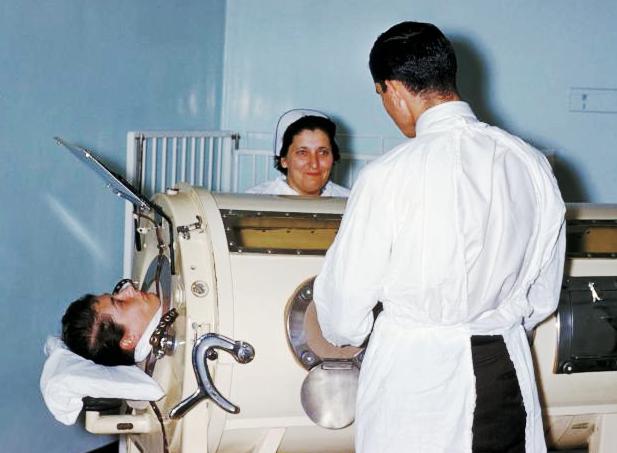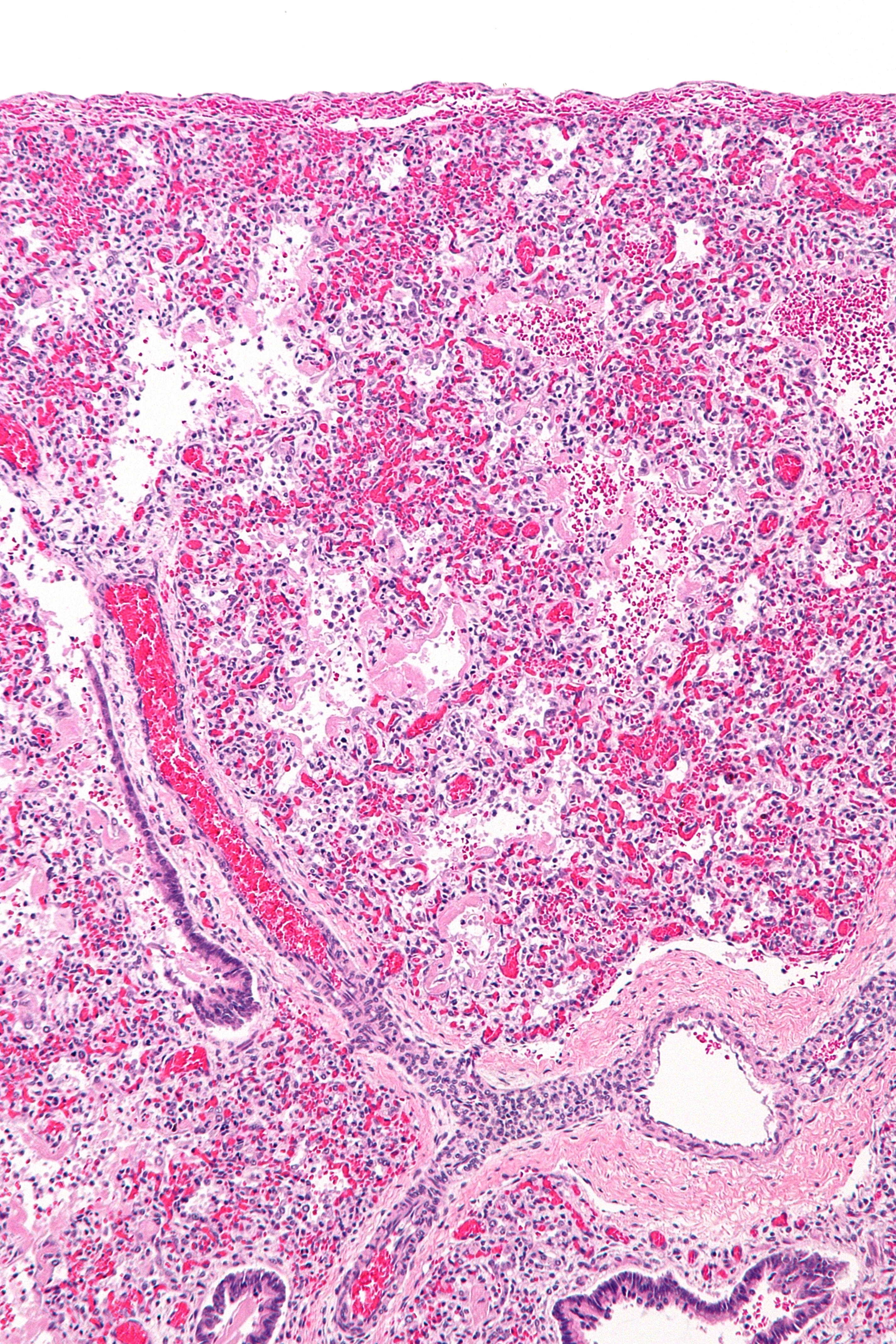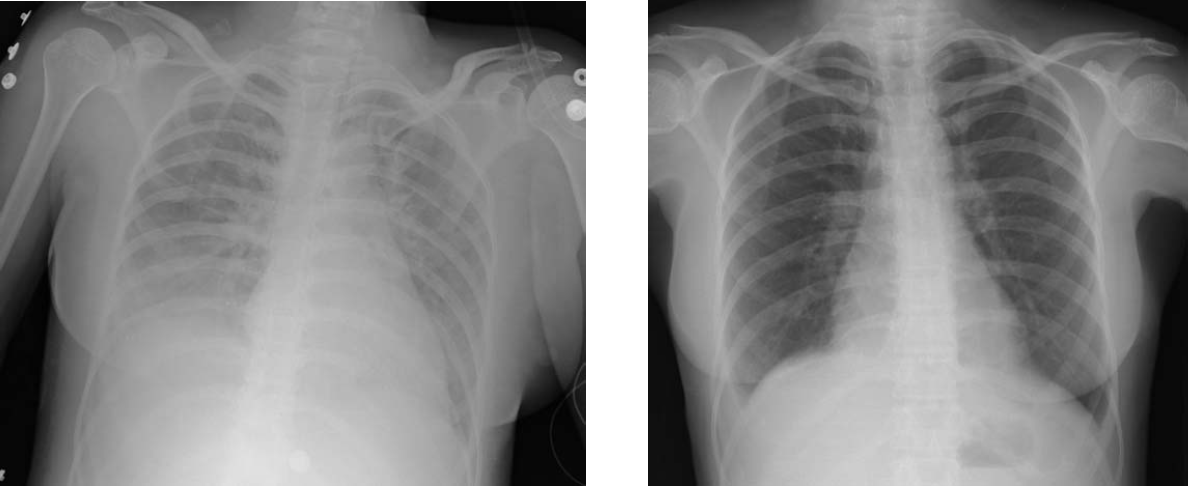|
Tidal Volume
Tidal volume (symbol VT or TV) is the volume of air moved into or out of the lungs during a normal breath. In a healthy, young human adult, tidal volume is approximately 500 ml per inspiration or 7 ml/kg of body mass. Mechanical ventilation Tidal volume plays a significant role during mechanical ventilation to ensure adequate ventilation without causing trauma to the lungs. Tidal volume is measured in milliliters and ventilation volumes are estimated based on a patient's ideal body mass. Measurement of tidal volume can be affected (usually overestimated) by leaks in the breathing circuit or the introduction of additional gas, for example during the introduction of nebulized drugs. Ventilator-induced lung injury such as Acute lung injury (ALI) /Acute Respiratory Distress Syndrome Acute respiratory distress syndrome (ARDS) is a type of respiratory failure characterized by rapid onset of widespread inflammation in the lungs. Symptoms include shortness of breath (dy ... [...More Info...] [...Related Items...] OR: [Wikipedia] [Google] [Baidu] |
Mechanical Ventilation
Mechanical ventilation, assisted ventilation or intermittent mandatory ventilation (IMV), is the medical term for using a machine called a ventilator to fully or partially provide artificial ventilation. Mechanical ventilation helps move air into and out of the lungs, with the main goal of helping the delivery of oxygen and removal of carbon dioxide. Mechanical ventilation is used for many reasons, including to protect the airway due to mechanical or neurologic cause, to ensure adequate oxygenation, or to remove excess carbon dioxide from the lungs. Various healthcare providers are involved with the use of mechanical ventilation and people who require ventilators are typically monitored in an intensive care unit. Mechanical ventilation is termed invasive if it involves an instrument to create an airway that is placed inside the trachea. This is done through an endotracheal tube or nasotracheal tube. For non-invasive ventilation in people who are conscious, face or nasal ... [...More Info...] [...Related Items...] OR: [Wikipedia] [Google] [Baidu] |
Breathing Circuit
A breathing system or breathing circuit is a medical device used to deliver oxygen, remove carbon dioxide, and deliver inhalational anaesthetic agents to a patient. Originally developed for use in anaesthesiology, many variants of breathing system are in clinical use, but most comprise a source of fresh gas flow, a length of breathing tubing to direct the gas, an adjustable pressure limiting valve to control pressure within the system and direct waste away, and a reservoir bag to allow assisted ventilation. Types There are many forms of breathing system, each having somewhat different mechanisms of action. They have traditionally been classified by the way in which the system interacts with fresh air from the surrounding atmosphere, and by whether the patient rebreathes gases that they have previously exhaled. However, there is no international standard for classifying breathing systems, and the terms "semi-open" and "semi-closed" may cause confusion in particular between US and ... [...More Info...] [...Related Items...] OR: [Wikipedia] [Google] [Baidu] |
Nebulizer
In medicine, a nebulizer (American English) or nebuliser (British English) is a drug delivery device used to administer medication in the form of a mist inhaled into the lungs. Nebulizers are commonly used for the treatment of asthma, cystic fibrosis, COPD and other respiratory diseases or disorders. They use oxygen, compressed air or ultrasonics, ultrasonic power to break up solutions and suspensions into small aerosol droplets that are inhaled from the mouthpiece of the device. An aerosol is a mixture of gas and solid or liquid particles. Medical uses Guidelines Various asthma guidelines, such as the Global Initiative for Asthma Guidelines [GINA], the British Guidelines on the management of Asthma, The Canadian Pediatric Asthma Consensus Guidelines, and United States Guidelines for Diagnosis and Treatment of Asthma each recommend metered dose inhalers in place of nebulizer-delivered therapies. The European Respiratory Society acknowledge that although nebulizers are used in hos ... [...More Info...] [...Related Items...] OR: [Wikipedia] [Google] [Baidu] |
Acute Lung Injury
Acute respiratory distress syndrome (ARDS) is a type of respiratory failure characterized by rapid onset of widespread inflammation in the lungs. Symptoms include shortness of breath (dyspnea), rapid breathing (tachypnea), and bluish skin coloration (cyanosis). For those who survive, a decreased quality of life is common. Causes may include sepsis, pancreatitis, trauma, pneumonia, and aspiration. The underlying mechanism involves diffuse injury to cells which form the barrier of the microscopic air sacs of the lungs, surfactant dysfunction, activation of the immune system, and dysfunction of the body's regulation of blood clotting. In effect, ARDS impairs the lungs' ability to exchange oxygen and carbon dioxide. Adult diagnosis is based on a PaO2/FiO2 ratio (ratio of partial pressure arterial oxygen and fraction of inspired oxygen) of less than 300 mm Hg despite a positive end-expiratory pressure (PEEP) of more than 5 cm H2O. Cardiogenic pulmonary edema, as ... [...More Info...] [...Related Items...] OR: [Wikipedia] [Google] [Baidu] |
Acute Respiratory Distress Syndrome
Acute respiratory distress syndrome (ARDS) is a type of respiratory failure characterized by rapid onset of widespread inflammation in the lungs. Symptoms include shortness of breath (dyspnea), rapid breathing (tachypnea), and bluish skin coloration (cyanosis). For those who survive, a decreased quality of life is common. Causes may include sepsis, pancreatitis, trauma, pneumonia, and aspiration. The underlying mechanism involves diffuse injury to cells which form the barrier of the microscopic air sacs of the lungs, surfactant dysfunction, activation of the immune system, and dysfunction of the body's regulation of blood clotting. In effect, ARDS impairs the lungs' ability to exchange oxygen and carbon dioxide. Adult diagnosis is based on a PaO2/FiO2 ratio (ratio of partial pressure arterial oxygen and fraction of inspired oxygen) of less than 300 mm Hg despite a positive end-expiratory pressure (PEEP) of more than 5 cm H2O. Cardiogenic pulmonary edem ... [...More Info...] [...Related Items...] OR: [Wikipedia] [Google] [Baidu] |
The Cochrane Collaboration
Cochrane (previously known as the Cochrane Collaboration) is a British international charitable organisation formed to organise medical research findings to facilitate evidence-based choices about health interventions involving health professionals, patients and policy makers. It includes 53 review groups that are based at research institutions worldwide. Cochrane has approximately 30,000 volunteer experts from around the world. The group conducts systematic reviews of health-care interventions and diagnostic tests and publishes them in the Cochrane Library. According to the Library, articles are available via one-click access, but some require paid subscription or registration before reading. A few reviews, in occupational health for example, incorporate results from non-randomised observational studies as well as controlled before–after (CBA) studies and interrupted time-series studies. History Cochrane, previously known as the Cochrane Collaboration, was founded in 1 ... [...More Info...] [...Related Items...] OR: [Wikipedia] [Google] [Baidu] |
Respiratory Physiology
In physiology, respiration is the movement of oxygen from the outside environment to the cells within tissues, and the removal of carbon dioxide in the opposite direction that's to the environment. The physiological definition of respiration differs from the biochemical definition, which refers to a metabolic process by which an organism obtains energy (in the form of ATP and NADPH) by oxidizing nutrients and releasing waste products. Although physiologic respiration is necessary to sustain cellular respiration and thus life in animals, the processes are distinct: cellular respiration takes place in individual cells of the organism, while physiologic respiration concerns the diffusion and transport of metabolites between the organism and the external environment. Gas exchanges in the lung occurs by ventilation and perfusion. Ventilation refers to the in and out movement of air of the lungs and perfusion is the circulation of blood in the pulmonary capillaries. In mammals, physi ... [...More Info...] [...Related Items...] OR: [Wikipedia] [Google] [Baidu] |
Respiration
Respiration may refer to: Biology * Cellular respiration, the process in which nutrients are converted into useful energy in a cell ** Anaerobic respiration, cellular respiration without oxygen ** Maintenance respiration, the amount of cellular respiration required for an organism to maintain itself in a constant state * Respiration (physiology), transporting oxygen and carbon dioxide between cells and the external environment ** Respiratory system, the anatomical system of an organism used for respiration ** Breathing, passing air in and out through respiratory organs ** Aquatic respiration, animals extracting oxygen from water ** Artificial respiration, the act of simulating respiration, which provides for the overall exchange of gases in the body by pulmonary ventilation, external respiration and internal respiration ** Cheyne–Stokes respiration, an abnormal pattern of breathing characterized by progressively deeper and sometimes faster breathing, followed by a gradual de ... [...More Info...] [...Related Items...] OR: [Wikipedia] [Google] [Baidu] |



